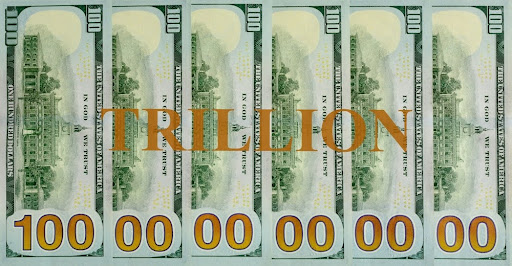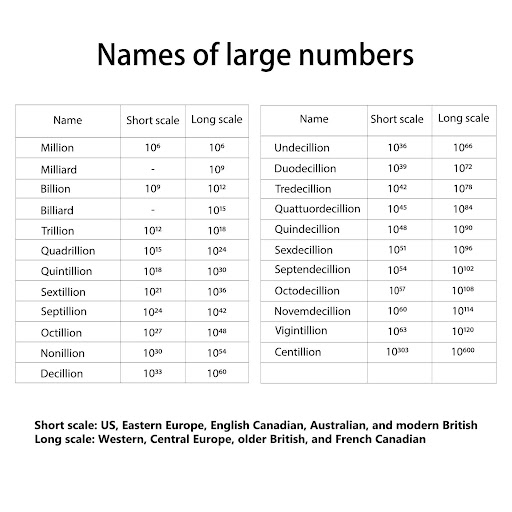Update: This article was last updated on 14th July 2025 to reflect the accuracy and up-to-date information on the page.
If you have ever asked yourself, “What comes after a trillion?” you are not alone. These days, it is not just math nerds who are thinking big numbers. Economies are measured in trillions; significant science (e.g., coal reserves in zettatons) and tech (e.g., data in exabytes) also rely on large measures, and understanding large numbers is becoming almost necessary. After you wrap your mind around a trillion (1,000,000,000,000), you may be thinking about what comes after a trillion, or even what comes after a quadrillion. This may seem like an academic exercise, but these matters. We will deal with the issues associated with what comes after quintillion or what comes before sextillion to the gargantuan tasks of thinking through steps on what comes after septillion or what comes after decillion. There is something unique about the intellectual gymnastics and creative work associated with naming and conceptualizing huge numbers. In this blog, we will go through a fun and interesting experience of what comes after a trillion from quadrillion and beyond, even to amazing numbers like a googolplex! Let’s go!
What number Comes After Trillion?

The number that follows a trillion is a quadrillion, which is a 1 followed by 15 zeros. Written out, it looks like this: 1,000,000,000,000,000. Beyond quadrillion, we continue adding sets of three zeros to the number, each with its unique name:
- Trillion = 1,000,000,000,000 (10^12)
- Quadrillion = 1,000,000,000,000,000 (10^15)
- Quintillion = 1,000,000,000,000,000,000 (10^18)
There are some numbers between trillion and quadrillion. For example, two trillion, five hundred trillion, but they only receive a new name once we add another three zeros and reach quadrillion. This naming structure is normal and predictable, continuing every time a new “million” is added, and then it will follow the same pattern which is an easy way to remember the names. You should feel confident with these as numbers get large, as you now see sequentially just as it is written.
The naming of large numbers follows this well formed structure, and now you know words like quadrillion, quintillion, sextillion, septillion, and more sequenced large numbers, which by their definition and sequential nature is a logical order. So if you are wondering, “what is after a trillion?” you have a clear naming structure so you can find it again with words like, what is after quadrillion, what is after quintillion, what is after sextillion, what is after septillion, what is after decillion, and on and on it goes.
Names of Large Numbers: From Million to Googolplex

Beyond trillion and quadrillion, there’s a whole series of big numbers. Here’s a list of some of the most significant numbers, including some that go far beyond what we encounter in daily life:
Name | Number |
Million | 1 x 10^6 (1,000,000) |
Billion | 1 x 10^9 (1,000,000,000) |
Trillion | 1 x 10^12 |
Quadrillion | 1 x 10^15 |
Quintillion | 1 x 10^18 |
Sextillion | 1 x 10^21 |
Septillion | 1 x 10^24 |
Octillion | 1 x 10^27 |
Nonillion | 1 x 10^30 |
Decillion | 1 x 10^33 |
Googol | 1 x 10^100 |
Googolplex | 1 x 10^(10^100) |
What Is a Googol and a Googolplex?

You may have heard of googol before (no, not the search engine!) A googol is a significant number: a 1 followed by 100 zeros. While it serves no real purpose in math on a day-to-day basis, it is an incredible concept that helps to showcase just how enormous the world of large numbers is. If you wonder what comes after a trillion, or even what comes after quadrillion, Googol is a great place to start. But wait—there’s more! A Googolplex (yes, it does, exist) is even more unbelievable. It is a 1 followed by a googol of zeros enough that even if we used all the atoms in the universe as an instrument of writing, there would still not be enough space to write it out.
In fact, after million, billion, trillion, quadrillion, and quintillion, we then reach sextillion, septillion, octillion, nonillion, and decillion. Wondering what’s after trillion, or what is after trillion? Great! You are right on point! Even what comes after sextillion or what comes after septillion might seem incomprehensible—but a googol and googolplex take that one step further.
Fun Facts About Large Numbers
- Centillion: A centillion is a 1 followed by 303 zeros. This number is far beyond what we typically encounter in any practical use, but it has its place in the naming structure of large numbers.
- Skewes’ Number: A famous mathematician, Stanley Skewes, introduced Skewes’ number, which is 10^(10^10). It was the largest number ever used in a mathematical proof when it was first discovered in 1933.
- Graham’s Number: This number is so large that conventional mathematical notation can’t express it. It’s widely regarded as the largest number ever used in a mathematical proof, far beyond human comprehension.
How to Understand Extremely Large Numbers
It’s easy to get lost when dealing with large numbers. How do you visualize something like a quadrillion or googol? Here are a few comparisons that can help:
Counting to a trillion: If you attempted to count to a trillion one number at a time, it would take you around 31,709 years to get there! This leaves us in suspense of what comes after a trillion or what comes after a trillion.
What comes after a trillion? After a trillion, the next number is quadrillion, then quintillion, sextillion, septillion… and so on. I know you’re wondering what comes after quadrillion, what comes after quintillion, or even what comes after sextillion and what comes after septillion; the number scale just keeps going! The next number is octillion, then nonillion, and what comes after decillion is undecillion.
Googol: If you wrote out a googol by hand, it would take you an extremely long time since it’s a 1 with 100 zeros after it.
Googolplex: Writing out a googolplex, a number so enormous that there isn’t enough paper in the world to do so, boggles the mind. To put it simply, it’s bigger than you can imagine.
Real-World Applications of Large Numbers
You might not think much about such massive amounts and big numbers, but large numbers are real things, and they exist to be used in the world. The thing is, many people often ask what comes after a trillion…what comes after a trillion… or even what is after a trillion; big numbers are more relevant than you may realize.
Economics: often national debts are in the trillions, and many global economies are in quadrillions, leading to the inquiry as to what comes after quadrillion (the answer is quintillion, then sextillion, septillion, etc.).
Astronomy: when astronomers talk about the number of stars or galaxies, they use terms like sextillion or septillion. This leaves one wondering what comes after sextillion and what comes after septillion.
Data: as we measure all data in the digital world, we are measuring in petabytes (10^15 bytes) and exabytes (10^18 bytes) the largest sizings drive this consideration of what comes after a quintillion and what comes after a decillion.
These words form part of the curriculum of large numbers, which continue on for decades after decillion, and keep in mind, both in distance, our universe is infinitely expanding as are our needs for data.
Beyond the Trillion: A Growing Numerical Universe
With the momentum in science & technology, large numbers are going to become even more relevant than before. As data continues to grow, exploration continues in space and as discoveries are still made, we may need even larger numbers to quantify what is already happening. Many people are already asking, “what comes after trillion?, “what is after trillion?,” and “what comes after a trillion?,” as old number scales seem irrelevant. Once you cover million, billion, trillion, there is quadrillion, quintillion, sextillion, septillion – and it keeps going from there. So it is no wonder we wonder what comes after quadrillion? what comes after a quintillion? What comes after sextillion? What comes after septillion? Eventually, the dollar amounts move into decillion, and certainly it begs the question, what comes after decillion? These large quantities are beginning to exhibit the need of understanding and defining larger unit numbers that exist beyond our normal base of number knowledge.
Conclusion
What comes after a trillion? It’s quadruple, quintuple, sex, etc. If you’ve ever asked yourself what comes after trillion or after a quadrillion or what comes after a quintillion, you aren’t alone! These big numbers may feel a world away from our everyday lives, but they can help remind us how large and complex our universe – and planet – can be. From national debts to the number of stars in the universe, they allow us to contextualise things on a macro level. You might even ponder, what comes after sextillion? What comes after septillion? What come after decillion? Whats after trillion? Its a step towards the infinite, and who knows?! You could even be working with some of these huge numbers in the future.
You can opt for our Advanced Math or Vedic Math+Mental Math courses. Our Math Quiz for grades 3rd, 4th, 5th, and 6th helps in further exciting and engaging in mathematics with hands-on lessons.













